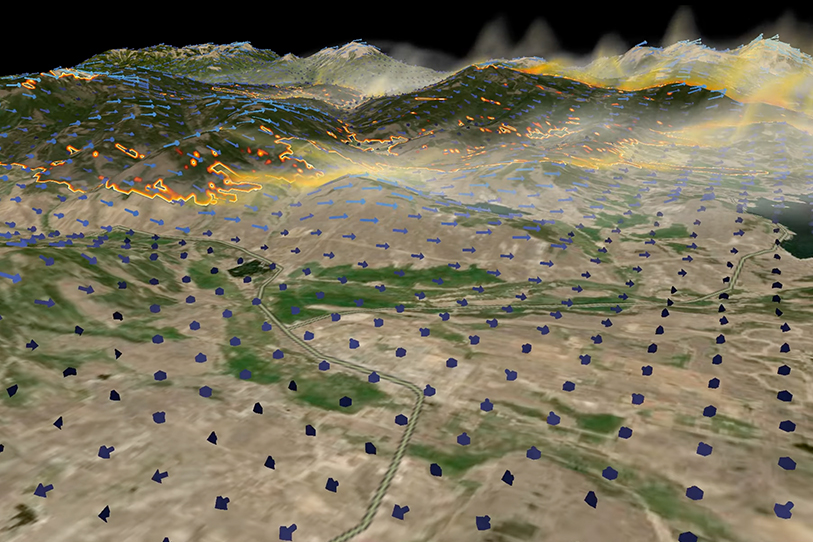Communication Drives Collaboration and Implementation
Brilliant minds working on the Wildland-urban interface (WUI) are all around us. Sometimes we just need to look, ask, or get engaged. The challenges of wildfires are complex. Wildfire behavior combined with human behavior is super complex…. These two behaviors clash when it comes to evacuation.
Katherine Conner, Chris Dyal, and I attended a great presentation and discussion last week at NCAR, our National Center for Atmospheric Research in Boulder, CO. The topic was Leaving it all behind: Evacuation lessons from wildfires in Colorado. I highly recommend watching the video of the talk.
The talk featured the scientists below. The first two studied the responses of the residents affected by the Marshall and East Troublesome fires, specifically on the matter of evacuation. The other two presented the cutting-edge developments at NCAR in modelling fire behavior.
Dr. Catrin Edgeley is an Assistant Professor of Natural Resource Sociology in the School of Forestry at Northern Arizona University and an Early Career Faculty Innovator with NCAR in the program’s second cohort. As a wildfire social scientist, she explores how communities are adapting to and recovering from wildfire. Her research to date has spanned nine US states and several notable wildfires, including the 2019 Camp Fire in California. She earned her PhD in Natural Resources from the University of Idaho and holds an MSc in Risk and Environmental Hazards and a BSc in Geography from Durham University in the UK.
William Cannon is currently a PhD student in The School of Forestry at Northern Arizona University (NAU), working with Dr. Catrin Edgeley as part of the Early Career Faculty Innovator Program. His current work in wildfire social science explores how socially diverse communities interpret and respond to fire in evacuation and recovery contexts. Using a qualitative interview approach, he investigates the diverse perspectives, knowledge, and experiences of communities affected by wildfires, aiming to identify effective strategies and approaches that can facilitate a more inclusive and informed decision-making process. He earned an MSc in geography at NAU and a BSc in geography from the University of Utah.
Dr. Timothy Juliano is a Project Scientist at the Research Applications Laboratory of the National Center for Atmospheric Research (NCAR). Timothy joined NCAR in 2019 as a Postdoctoral Fellow after earning his BS degree in Meteorology from Millersville University (2013) and his MS (2015) and PhD (2018) degrees in Atmospheric Science from the University of Wyoming. His research focuses on numerical weather prediction, with interests spanning a variety of lower atmospheric problems including boundary layer dynamics and turbulence, wildland fire prediction, meteorological impacts on renewable energy, and aerosol-cloud interactions.
Scott Pearse is a software engineer at the National Center for Atmospheric Research (NCAR), where he helps develop the VAPOR 3D visualization package for the geophysical sciences. Before joining NCAR, Scott designed and deployed remote sensing systems for atmospheric physicists and produced Quantitative Precipitation Estimation (QPE) analyses for various government agencies. He holds a BS in Electrical Engineering, and an MS in Computer Science from the University of Colorado Boulder.
But the needed synergy between the sociology and technology is central to my point here.
Cat and Will discussed their findings on resident attitudes, opinions and behaviors with respect to evacuation. Every resident needs a plan for evacuation. While it's obvious in hindsight, for someone who has never been through this harrowing scenario, evacuation has many variables and elements that an unexperienced or uninformed person may not be ready to execute. First, it's not simple to get the evac orders to everyone that needs them. Second, when the notice is received, there are many financial, emotional, and logistical reasons why those orders are not immediately followed. Cat’s work uncovered and ranked the reasons given by residents.
We have an amazing community of fire, forestry, watershed, and public safety professionals working on every aspect of this problem. They are doing research and putting lessons learned into practice as fast as they can, usually scrounging for resources (money) wherever they can find it. But this is a team effort. We need to develop more efficient, trusted channels of communication and all of us that live in the WUI need to pitch in. We need to do the mitigation, planning and preparation to build a more resilient wildland, but when they say “go” we need to go.
We need to accelerate the time between the research and the communication, education, and readiness of our residents. We need to include those that visit our wildlands on the weekends. This isn’t just the responsibility of our firefighting crews.
Again, quoting Cat, this is not a problem at 50,000 ft. It’s a challenge on the ground, in crazy conditions, making decisions under stress when you can’t see the fire line until it’s too late. We need to go to our neighbors, our town meetings, public seminars, HOA meetings and sometimes just walk next door to make sure those in our communities that aren’t “plugged in” have their plans and are ready to go. Cat says, “Don’t wait for a fire to come at you to have a family conversation.”
The CWPP process and outcomes are the best place to start. Get a copy and get involved. These lay down the baseline of information everyone needs to develop their plan. If you can, help our professionals communicate it. You may save someone’s life.
Need some help? Contact us. We’re working on a map creation and collaboration platform for counties to collect, keep current and communicate this information. Ultimately, our tool will allow you to create your personal CWPP so you and your neighbors can count on accurate and complete information when the next one hits. It’s engineered to be the place where you can get the latest without sifting through ads or misinformation.
Finally, I recommend the NCAR Explorer Series. We are lucky to have this resource locally doing serious technical work on weather, climate, fire, etc. And I have to mention Colorado State University. They are thought leaders in forestry, watershed, wildland and wildfire research for the entire country and they are just up the road.
Photo Credit: https://edec.ucar.edu/events/2023-innovator-panel-wildfires


